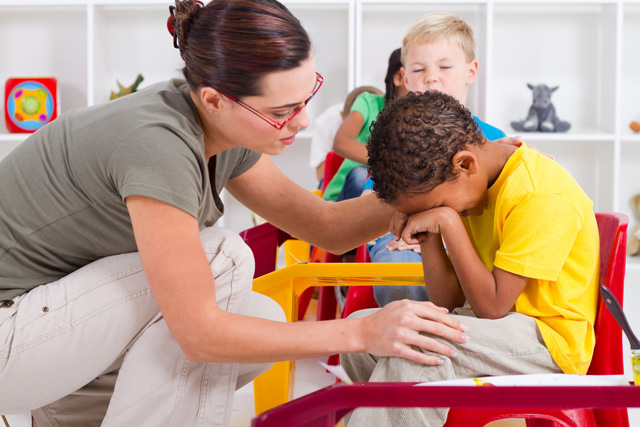Big feelings can be overwhelming, and when young children get upset, it can be equally overwhelming for their teachers. Teachers can teach children several calm-down techniques such as breathing strategies, asking for a hug, doing wall or chair push-ups, or taking a break.
These strategies should be taught before a child is upset and not in the middle of a tantrum. However, simply teaching children strategies does not ensure that they will use them when they’re upset or support them when they get upset in the middle of the school day. We will describe four steps teachers can take to support children before, during, and after big feelings arise.
Before the Feelings Occur
- Teach children strategies to help them learn to calm down. It is important to teach and review calm-down strategies when children are calm. During large and small group activities, teachers can share a social story about calming down or role play calm-down strategies such as taking deep breaths. For example, teachers can lead a brief calm-down activity during morning meeting where the children practice using Tucker the Turtle. As the teacher reads the Tucker the Turtle social story, the children walk through the steps Tucker uses. As a group, children can practice by using these four steps:
- Recognize when you’re feeling mad or upset
- Stop yelling and keep your body to yourself
- Tuck inside your shell and take three deep breaths
- Come out of your shell when you’re ready to think of a solution for your problem
- When you feel upset, model the strategies you teach. Even the best teachers can get angry and frustrated on a hard day. When you feel yourself getting upset, consider it an opportunity to model the strategies you have taught your students. For example, Miss Cassie teaches her students to go sit in a “Cozy Corner” when they feel angry. One day, during cleanup, the children were not on task and Miss Cassie felt herself getting angry. Miss Cassie stated loudly, “I’m feeling frustrated that my friends aren’t cleaning up. I’m going to go calm down.” She then walked over and plopped down in the “Cozy Corner” to take deep breaths.
By labeling her emotions authentically and modeling the behavior she would like to see the children perform, Miss Cassie is increasing the likelihood of children using the calm down strategies they have been taught. And she helped herself through a difficult moment!
While the Feelings Occur
- Provide individualized support when a child is feeling upset or frustrated. Big Feelings will inevitably arise even after children have been taught how to calm down. In these moments, it’s important to offer individualized support to children. Adults should take a few deep breaths before beginning so as to be centered and ready. When the child is upset, adults can label the emotion and model calm down strategies. For example, “Balquisa, you look angry right now. When you’re angry, you can take deep breaths like this [inhale, exhale] or you can say, ‘I need a hug.’”
Sometimes talking to an upset child can make things more difficult. They may start screaming or try running away. If this happens, offer some visual choices. If you have a poster of calm-down strategies in your classroom, show the poster and point to a choice. Here are a few examples of calm-down posters about emotional regulation and breathing strategies.
After the Feelings Occur
- Provide descriptive feedback to a child who has calmed down. Support the child to reengage in an activity or problem solve. Recognize that a child has successfully calmed their body by describing what the child did to calm down. You might say, “You were angry because Jacob didn’t want to play with you. I saw you take some deep breaths and calm down.”
Help the child reflect about how they are feeling once they’ve calmed down by saying, “How do you feel now?” Pointing out that they look relaxed can help children make connections between how they physically feel when they are upset versus when they are calm.
Help the child think through possible solutions to the problem they were facing or help the child reengage in a new activity. To problem solve you might say, “Now that you’re calm, would you like some help problem solving how to get the toy you want?” To support engagement you could say, “I see that you’re calm now. I know you were frustrated that we had to come in from the playground. It’s choice time. Would you like to paint or play blocks first?”
Preschool is a time of expansive social-emotional skill development, and big feelings can arise quickly. As teachers, a large part of our job is to teach and support children as they learn how to recognize and cope with these feelings.

Abby Taylor
Abby Taylor works as a doctoral student studying early childhood special education at Vanderbilt University. She has been supporting teachers and childcare programs in the Nashville area in implementing the Pyramid Model on several IES-funded projects since 2016. Abby is passionate about supporting teacher’s promotion of children’s social-emotional development.
Biography current as of 2021

Kate Nuhring
Kate Nuhring is a doctoral student studying early childhood special education at Vanderbilt University. She received her master’s degree in early childhood special education at Vanderbilt University in 2020 after spending nearly a decade as a Head Start teacher and administrator. She is passionate about working with teachers to guide their support of young children who exhibit challenging behaviors.
Biography current as of 2021
Web Resources
-
Self-Regulation: Breathing Strategies
Source: National Center for Pyramid Model Innovations (NCPMI)
This webpage offers visual supports used to teaching children the skills of controlled breathing and belly breathing.
-
Tucker Turtle Takes Time to Tuck and Think
Source: National Center for Pyramid Model Innovations (NCPMI)
This webpage provides a scripted story to assist with teaching the “Turtle Technique”, a decision-making strategy.


